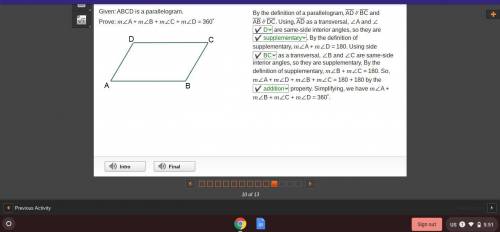
Mathematics, 05.08.2020 02:01 deezy2x
Given: ABCD is a parallelogram. Prove: m∠A + m∠B + m∠C + m∠D = 360˚By the definition of a parallelogram, AD∥BC and AB∥DC. Using, AD as a transversal, ∠A and ∠ are same-side interior angles, so they are . By the definition of supplementary, m∠A + m∠D = 180. Using side as a transversal, ∠B and ∠C are same-side interior angles, so they are supplementary. By the definition of supplementary, m∠B + m∠C = 180. So, m∠A + m∠D + m∠B + m∠C = 180 + 180 by the property. Simplifying, we have m∠A + m∠B + m∠C + m∠D = 360˚.1) D2) Supplementary3) BC4) Addition

Answers: 3


Another question on Mathematics

Mathematics, 21.06.2019 15:00
Find the sum of the measure of the interior angles of a polygon of 9 sides ; of 32 sides
Answers: 1

Mathematics, 21.06.2019 20:00
The midpoints of the sides of the large square are joined to form a smaller square. what is the area of the smaller square
Answers: 1

Mathematics, 21.06.2019 20:30
Answer for 10 points show work you guys in advanced < 3
Answers: 1

Mathematics, 21.06.2019 22:20
Which of the following equations are equivalent to -2m - 5m - 8 = 3 + (-7) + m? -15m = -4m -7m - 8 = m - 4 -3m - 8 = 4 - m m - 4 = -7m - 8 -8 - 7m = -4 + m -8 - 3m = 4 - m
Answers: 1
You know the right answer?
Given: ABCD is a parallelogram. Prove: m∠A + m∠B + m∠C + m∠D = 360˚By the definition of a parallelog...
Questions

Computers and Technology, 22.11.2019 15:31

Mathematics, 22.11.2019 15:31




Mathematics, 22.11.2019 15:31


Mathematics, 22.11.2019 15:31


Mathematics, 22.11.2019 15:31

English, 22.11.2019 15:31




Social Studies, 22.11.2019 15:31


English, 22.11.2019 15:31



Mathematics, 22.11.2019 15:31




